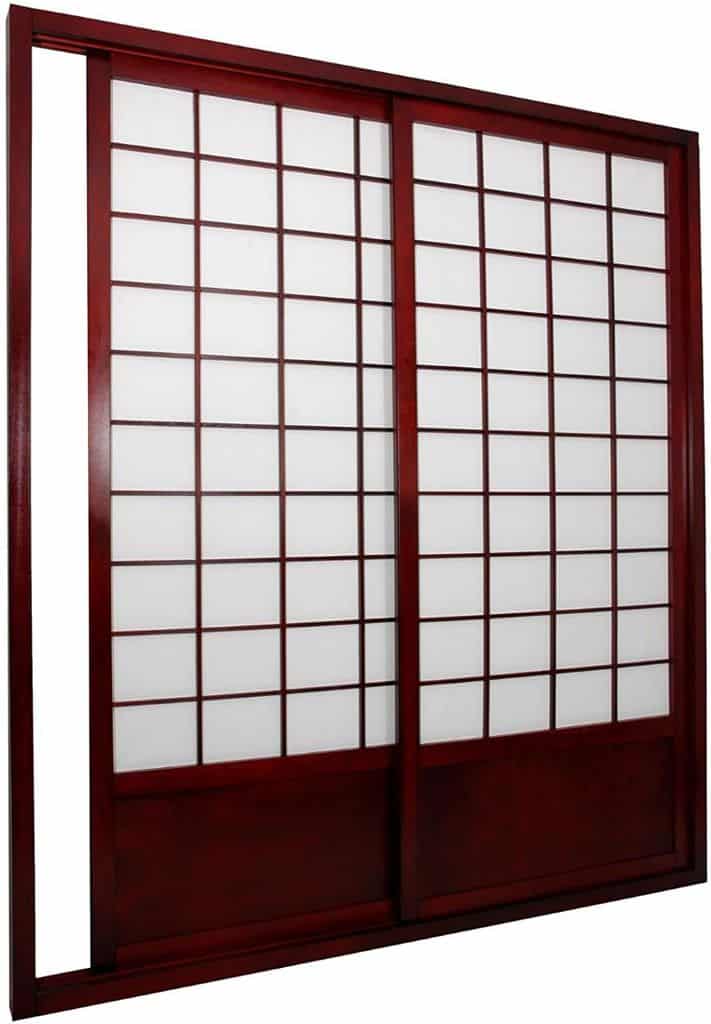Japan
Japanese Shoji Sliding Doors – Shoji Screen Sliding Doors
The Japanese Shoji Screens Sliding Doors are a pleasant way to allow light enter into your space or home. It can be suited to any contemporary or traditional interior, their Oriental flair makes them bold, breezy, and bright. Shoji Screens characterize the beautiful essence of Japanese interior style.
Asides from being used as an interior door, they can be placed behind glass or wooden sliding doors, their screens can act as curtains, helping to regulate the room temperature. They are very versatile in their usage as a contemporary modern interior, they can be used as small window screens, or as an entertainment system door, or cupboard, and they can also be used to separate spaces as a ceiling to the floor room divider.
They are elegant and beautiful doors and they definitely bring a touch of Japanese interior style to your space. Are you willing to give them a try? In this article, we have compiled a list of Japanese Shoji screen sliding doors for you that you can choose from.
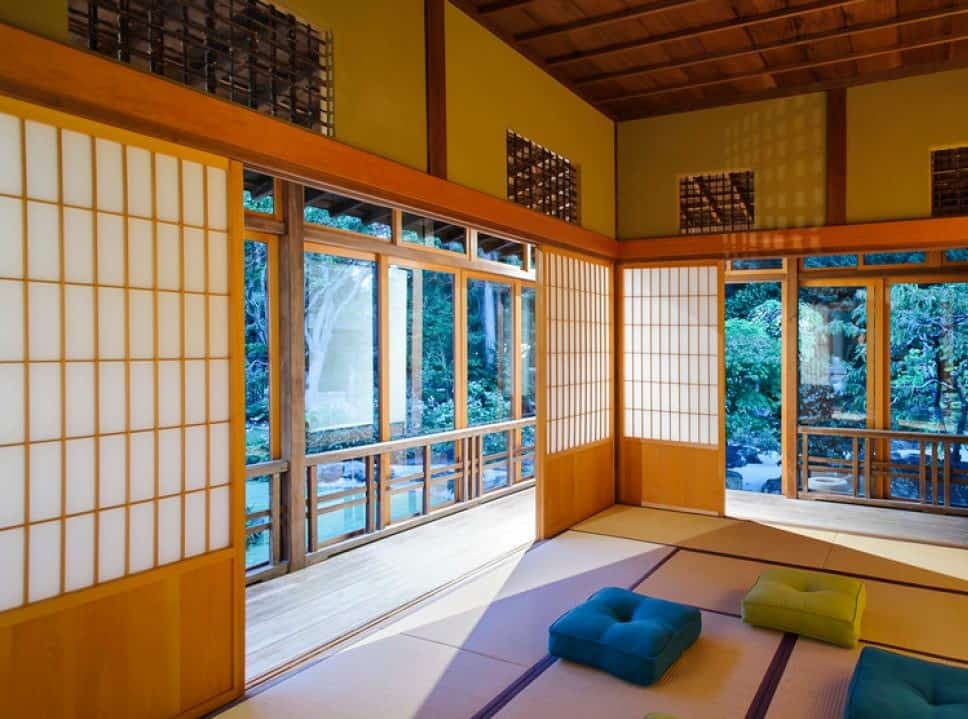
Some other articles you may want to read:
- Japanese Cherry Blossom Tree Decor
- Best Japanese Home and Room Décor with Review
- Beautiful Japanese Cherry Blossom Decor
- Traditional Japanese Floor Futon Mattress
Japanese Shoji Screen Sliding Door with reviews
Oriental Furniture 7 ft. Tall Zen Japanese Shoji Screen Sliding Door
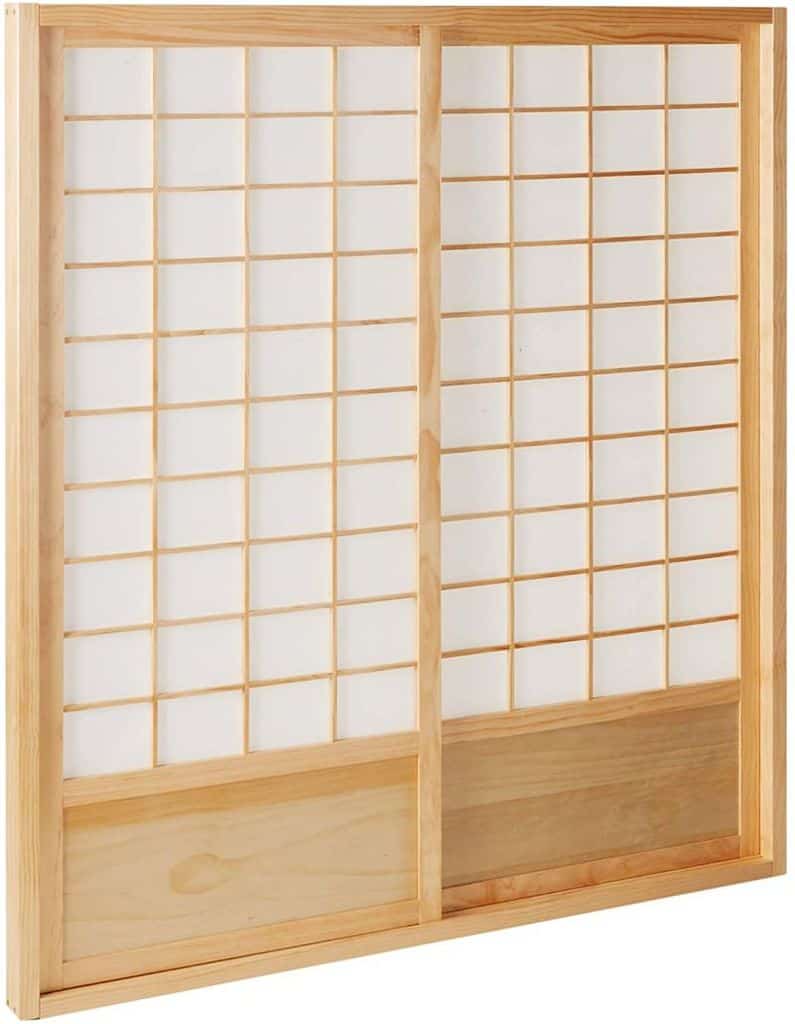
The Oriental Furniture 7 ft. Tall Zen Japanese Shoji Screen Sliding Door is 83″ tall × 73.5″ overall, but 83″ × 73.5″ × 3.5″ for rough opening and each door is 80″ × 36″ × 1″. The design is the classic traditional Japanese lattice, pulp paper reinforced shade, and the lattice design only on the front side.
The construction is high quality, the spruce is kiln dried, and the package comes with instructions for efficient professional installation. It has a variety of beautiful stain wood frame finishes which you can choose from such as rosewood, natural, honey, or, black, also includes jam and rails.
This fantastic Oriental Zen Shoji Screen Sliding Door package includes sliding doors, bottom and top tracks, and left and right door jambs. The dimension for jambs and tracks are approximately 3.50″Deep × 1.75″ Thick. Each of the doors measure approximately. 36.00″W by 80.00″H by 1.00″D.
They are sturdy and very durable, for effective installation hire a professional. Once they are installed be sure you would enjoy the sense of Asian interior design style, they will bring you your space.
Pros
- The construction is high quality
- The package comes with instructions for efficient professional installation
- Sturdy and has a thick frame.
Cons
- Fragile doors and softwood
Oriental Furniture 7 ft. Tall Cherry Blossom Japanese Shoji Screen Sliding Door
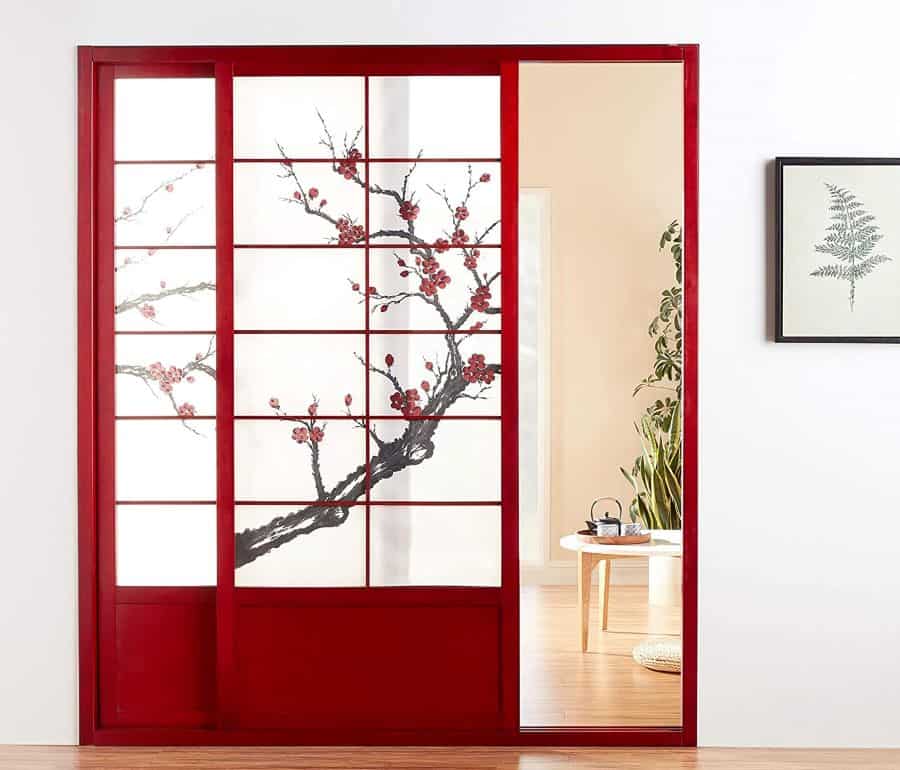
The Oriental Furniture 7 ft. Tall Cherry Blossom Japanese Shoji Screen Sliding Door is 83″ tall × 73.5″ overall but 83″ × 73.5″ × 3.5″ for rough opening and each door is 80″ × 36″ × 1″. This sliding door kit is for Interior use and it is Japanese style. The paper shade has a beautiful cherry blossom art tree print and this print complements any decor style.
It has a variety of beautiful stain wood frame finishes which you can choose from such as rosewood, natural, honey, or, black, also includes jam and rails. The product weighs 91 pounds. Hire the services of a professional for effective installation.
This gorgeous Cherry Blossom Japanese Shoji Screen Sliding Door package has only 2 sliding doors, bottom and top tracks, and left and right door jambs. Having these sliding doors in your home is a subtle and elegant way to add a sophisticated Asian touch to your home space.
Pros
- Has a beautiful cherry blossom tree art design
- Elegant, stunning, and sophisticated
- Excellent for interior use
Cons
- Not very wide, has only two doors
Oriental Furniture 7 ft. Tall Eudes Japanese Shoji Screen Sliding Door
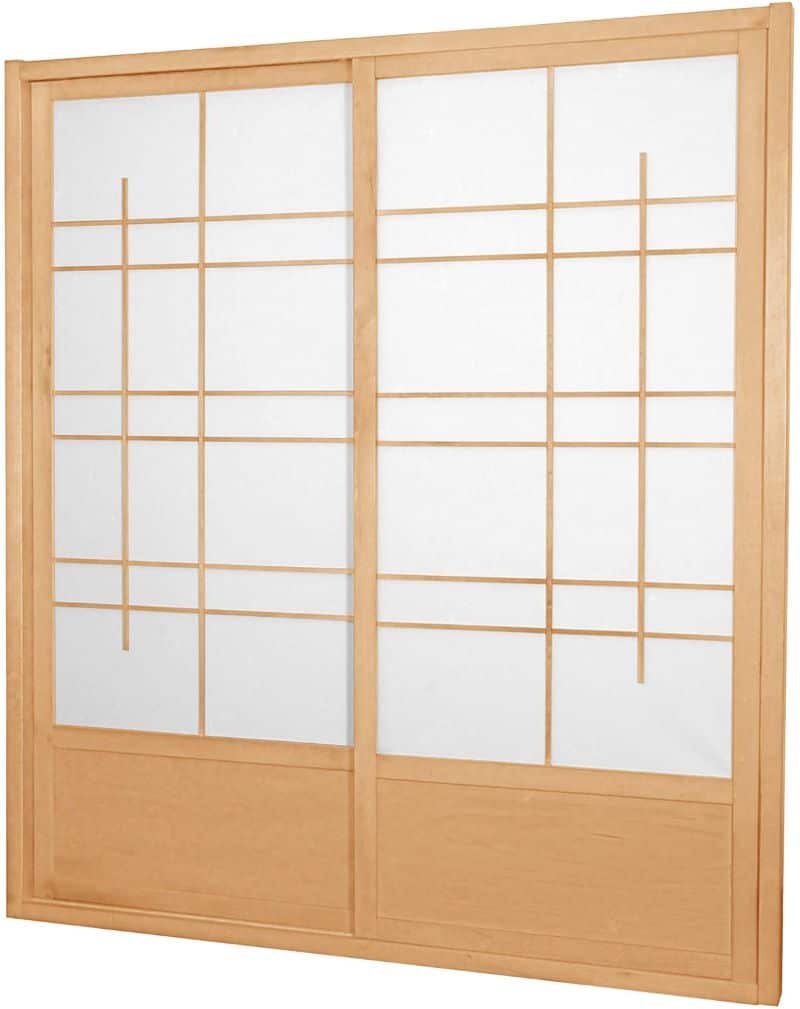
The Oriental Furniture 7 ft. Tall Eudes Japanese Shoji Screen Sliding Door lattice design is on both the front and backside. The lattice design is contemporary, unique, and it has a pulp paper reinforced shade. It is sturdy and it looks elegant.
It has a variety of beautiful stain wood frame finishes which you can choose from such as rosewood, natural, honey, or, black. The product dimensions are 83″ tall × 73.5″ overall, but 83″ × 73.5″ × 3.5″ for rough opening and each door is 80″ × 36″ × 1″. The package dimensions are 6 L by 86H by 36Winches.
This fantastic Oriental Furniture Eudes Japanese Shoji Sliding Door package comes with just two sliding doors, bottom and top tracks, and left and right door jambs. Its splendid and beautiful modern design gives an art decor feel and it has large geometric beautiful lattice work. You’ll get your money’s worth if you decide to purchase it.
Pros
- Contemporary and unique lattice design
- It is stunning and the quality is good
- The lattice design is double sided
Cons
- The door is heavy in size
The Oriental Furniture 7 ft. Tall Zen Japanese Shoji Screen Sliding Door product dimension is 83″ tall × 73.5″ overall, but 83″ × 73.5″ × 3.5″ for rough opening and each door is 80″ × 36″ × 1.”. The product also weighs 93 pounds.
The design is the classic traditional Japanese lattice, pulp paper reinforced shade. Also, lattice design is double-sided. The construction is high quality, the spruce is kiln dried, and the package comes with instructions for efficient professional installation.
This fantastic Oriental furniture Zen Japanese Shoji Screen Sliding Door package has sliding doors, bottom and top tracks, and left and right door jambs. Jambs and tracks are approx. 1.75″ Thick by 3.50″ Deep. Also, each of the doors measure approximately 36.00″W by 80.00″H by 1.00″D.
It has a variety of beautiful stain wood frame finishes which you can choose from such as rosewood, natural, honey, or, black, also includes jam and rails. Definitely an excellent purchase for a sturdy, elegant, and high-quality Japanese Shoji Screen sliding door.
Pros
- The lattice design is double-sided
- The construction is high quality
- Gives a soothing and beautiful Zen environment
Cons
- The sliding door frame has gaps
Japanese Shoji Screen Sliding Door Buying Guide
Here, we have provided for you some of the variations in the Japanese Shoji screen sliding doors in the market. Also, you’ll find in this buying guide features you should observe and keep in mind when purchasing the most suitable Shoji screen sliding door for yourself.
Types of Sliding System used for the Japanese Shoji Screen Sliding Doors
There are various types of Sliding systems used to construct tracks for the shoji sliding doors. We have compiled some of them for you in this section.
1. Wood on wood sliding system
This system is the most common. Metal tracks are placed upon the closure they are covered with strong wooden panels. When this method is used runners are not needed on the floor.
The division’s frame can be finished with beams made of wood along the vertical walls where your sliding door will come to a halt. The possible imperfections and inadequacies of the wall are evened out by these walls. The doors conveniently run on invisible special dowels screwed onto the floor in order to avoid swinging movements of any kind.
2. Pocket sliding door system
The pocket sliding door system is for Japanese Shoji Screen Sliding Doors that slide inside the walls. You can hire a professional to do this for you. They are very advantageous because you can have your entire door space open, this will allow for easy movement of heavy and wide house furniture.
In addition, more people can pass through such a door opening than the regular sliding door system that doesn’t allow for pocket sliding.
Features to be Considered before purchasing a Japanese Shoji Screen Sliding Door
Paintings on the shoji screen
The traditional artwork on a Japanese shoji screen sliding door also known as a Fusama door starts from the bottom because sitting on the plain floor is customary for everyone. The artwork on the screen was concentrated at the eye level where it can be seen very well. The artwork may be on the entire Shoji screen door as well.
Nature-themed scenes such as blooming flowers, regal peacocks, and tall mountains are common motifs used to paint Shoji screens. These painted Shoji screens are commonly used in temples and traditional or local Japanese buildings.
Door coverings that can be used for Japanese sliding doors
If your preferred door covering is a semi-transparent material that’ll allow sunlight to shine into your space, you should consider getting rice-paper on plexiglass, or rice-paper on inflexible polycarbonate layer, or rice-papers that have PVC coating that is double-sided, or simple fabrics.
If your preferred covering is something opaque that will block out light whenever closed, we advise you to get unfinished natural wooden panels or wood panels that are lacquered with water-based eco-friendly finishings. You can also get wooden panels that are enclosed with fabric either on one side or on the two sides.
Frequently Asked Questions
Is the Shoji Screen Waterproof?
The neutral look of shoji screens makes them a very good design for a bath or shower area, also the translucent nature of the screen panel maintains needed privacy and still allows light in. If the Shoji Screen door will come in contact with liquid or water, you have to make sure the screen of the door is waterproof.
Get a good sliding shoji screen panel that is made with translucent glass or waterproof acrylic plates. If you want to enclose your standalone bathtub, you should use a folding shoji screen made of 6-foot × 3-foot traditional rice paper shoji screen panels to create your needed relaxing and private area for bathing. You can as well use sliding doors made with plastic panels, they are also waterproof and can be used outdoor all year round.
Can Shoji Screen sliding doors be used for any other purpose asides interior doors?
Yes. The shoji screen sliding door can be used as a cabinet door. Also, 2 Shoji panels can be custom fitted on a good sliding track and serve as a double-panel under-sink kitchen cabinet, medicine cabinet or, bathroom vanity.
Shoji screen doors can function also as traditional doors that have hardware, hinges, and handles for opening out. Though for this, acrylic plate is more durable than rice paper. Shoji screens can similarly be used as sliding or traditional doors for bathroom storage or linen closet area.
Can Japanese Shoji Screen Sliding Doors be used in houses with sloping roofs?
Yes. Sloping roof houses can accommodate the Japanese Shoji screen sliding doors and they can also be easily installed. You can create the following depending on your roof type:
- Some wooden beams can be cut diagonally so you can compensate for the roof’s sloping angle.
- Floor-roof closures can be made with Shoji walls that have a diagonal cut which can be on the hinges or fixed on. You can then place your sliding doors below this closure.
Conclusion
Japanese Shoji Screen Sliding Doors are used generally for walk-in or fitted wardrobes, to create an entrance, to split a room into 2, to divide night and day areas in a house, and divide a kitchen and living room.
They can also function well as cabinet doors, doors used to partition anywhere in the house even the bathroom. Their usefulness also extends to workplaces and office areas, restaurants, hotels, and leisure places.
Their elegant and beautiful designs make them useful not only for partitioning spaces but for interior decoration. They can even be used only as an interior decoration piece. In this product review and buying guide we have put together all the information you need to know if you decide to get one of these iconic Japanese Shoji Screen Sliding Doors.

